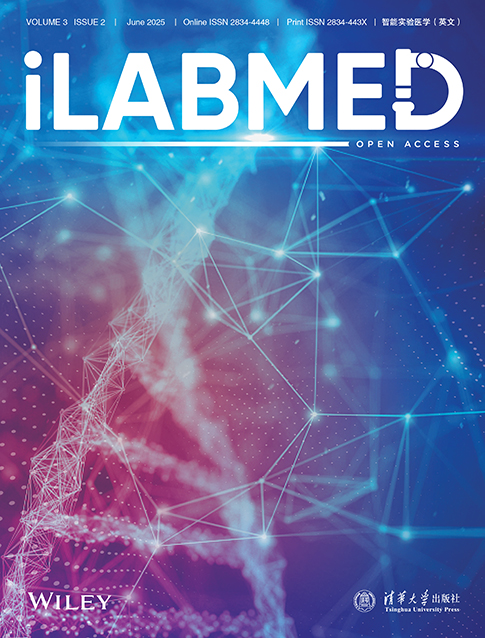Underlying Mechanism of Jiuwei Shengmai Powder in Improving Myocardial Hypoxia at High Altitude Based on Network Pharmacology and Molecular Docking
Funding: This work was supported by the Military Medical Innovation Project Special Project of the Health Bureau of the Logistics and Security Department of the Military Commission (18CXZ027), the Regional Surface Project of the National Natural Science Foundation of China (82260846), the Institute Capacity Building Program from Beijing Chest Hospital (NLTS2023-17), and the Applied Basic Research Project of Qinghai Provincial Science and Technology Department (2023-ZJ-754).
Cong Wu, Yanjuan Zhu, and Changpeng Xie contributed equally to this work and shared the co-first authorship.
ABSTRACT
Background
High altitude shock is attributed to myocardial ischemia and hypoxia. Jiuwei Shengmai powder has positive impacts on human physiology. However, it is unknown if it can mitigate myocardial ischemia and hypoxia. This study aimed to postulate the molecular mechanism that relieves myocardial hypoxia injury in officers and soldiers at high altitude after ingesting Jiuwei Shengmai powder by using network pharmacology and molecular docking.
Methods
The effective components and potential targets of Jiuwei Shengmai powder were detected by databases such as the traditional Chinese medicine systems pharmacology (TCMSP), PubChem, and UniProt. Target genes related to myocardial hypoxia injury were identified using Gene Cards, Online Mendelian Inheritance in Man, DrugBank, DisGeNET, the Comparative Toxicogenomics Database, and other databases. CytoScape was used to construct a “drug-active ingredient-target gene” network. Protein-protein interactions (PPIs) were predicted using the STRING database. Core gene target data were analyzed using Gene Ontology (GO) and Kyoto Encyclopedia of Genes and Genomes (KEGG) pathway enrichment utilizing R packages, while Autodock Vina was used to verify the molecular docking simulation.
Results
One hundred and sixteen active ingredients were identified in Jiuwei Shengmai powder and were shown to target 197 genes. Of these, 3073 core target genes were related to myocardial hypoxia injury, and 130 core genes were obtained after Veen intersection. There were 129 PPI nodes and 1769 edges. The docking binding energy was ≤ −5.0 kcal·mol−1, indicating strong binding between the active compounds and targets. Quercetin and kaempferol are the main components in Jiuwei Shengmai powder that relieve myocardial hypoxia injury. Their core targets are interleukin-6 and activated cysteine proteinase-3 antibody, which are mainly related to PI3K-Akt-, mitogen-activated protein kinase (MAPK), tumor necrosis factor (TNF), and interleukin 17 (IL-17) signaling pathways.
Conclusions
This study provides a strong theoretical basis to understand the interaction of the components in Jiuwei Shengmai powder with human genes and proteins that should help to plan biochemical studies to better understand myocardial hypoxia injury mitigation.
Abbreviations
-
- COX
-
- cyclooxygenase
-
- GO
-
- Gene Ontology
-
- IL-17
-
- interleukin 17
-
- KEGG
-
- Kyoto Encyclopedia of Genes and Genomes
-
- MAPK
-
- mitogen-activated protein kinase
-
- PPI
-
- protein-protein interaction
-
- ROS
-
- reactive oxygen species
-
- TCMSP
-
- traditional Chinese medicine systems pharmacology
-
- TNF
-
- tumor necrosis factor
1 Introduction
Plateaus account for approximately one sixth of the total area of China. Inhabitants of this environment are prone to hypoxia. The heart is characterized by high oxygen and energy consumption is highly sensitive to hypoxia. Even brief exposure to high altitude damages the body to varying degrees owing to the hypoxic response [1]. In plateau areas, soldiers are exposed to decreased oxygen partial pressure and oxygen saturation, which is mainly manifested in cardiac ischemia, increased burden, high altitude heart diseases, and myocardial remodeling [2]. Recent studies show that soldiers who rush to high altitude regions are prone to high altitude diseases caused by defense responses by the cardiovascular system, especially myocardial ischemia and hypoxia and cardiac insufficiency [3].
Western medicine mainly treats pathological changes in the human body through targeted vaccines, drugs, or surgeries. Meanwhile, traditional Chinese medicine has accumulated a wealth of treatment experience in regulating the body to resist diseases over thousands of years [4]. It adopts unique non-invasive methods such as syndrome differentiation and treatment, looking and listening, harmonizing the seven feelings, multi-target intervention, and unique prescriptions to treat difficult diseases. The original prescription of Jiuwei Shengmai powder is Shengmai powder, which was first described in “The Original of Medicine” by Zhang Yuansu, a physician in the Jin Dynasty [5]. Jiuwei Shengmai powder has significant therapeutic effects on cardiovascular diseases, and has good therapeutic effects on central nervous system diseases, endocrine system diseases, digestive system diseases, the immune and hematopoietic systems, shock, and so on [6]. However, the molecular basis of its physiological effects is not well known.
In this study, the key drug components and hub targets of Jiuwei Shengmai powder were analyzed using bioinformatics and molecular docking to propose the molecular pathways involved in mitigating the effects of myocardial hypoxia.
2 Methods
2.1 Identifying Proteins and Targets Genes of Jiuwei Shengmai Powder
The main components of recombinant Jiuwei Shengmai powder are Astragalus membranaceus, Panax ginseng, Atractylodes macrocephala Koidz, Ziziphus jujuba Polygonatum sibiricum, Angelica sinensis, Cornus officinalis, Ligustrum lucidum, Fructus cnidii, and Poria cocos. We screened the active ingredients and target proteins of Jiuwei Shengmai powder using the traditional Chinese medicine systems pharmacology (TCMSP) database and analysis platform. According to the criteria of ≥ 30% oral bioavailability and ≥ 0.18 drug likeness. UniProt is the most informative and resource-rich protein database, which is formed by integrating the data of Swiss-Prot (http://www.expasy.ch/sprot), TrEMBL (https://www.uniprot.org/help/uniprotkb), and PIR-PSD (https://proteininformationresource.org/pirwww/dbinfo/pir_psd.shtml) databases. The target proteins and genes of the Jiuwei Shengmai powder were identified in the UniProt database.
2.2 Determining Hypoxia-Related Disease Genes
“Myocardial hypoxia,” “myocardial ischemia,” “coronary heart disease,” and “myocardial remodeling” were used as keywords in Gene Cards (https://www.genecards.org/), Online Mendelian Inheritance in Man (https://omim.org/), Drug Bank (https://go.drugbank.com/), DisGENET (https://disgenet.com/), and the Comparative Toxicogenomics Database (https://ctdbase.org/).
2.3 Identifying Core Genes in Jiuwei Shengmai Powder and Constructing a Drug-Gene Relationship Network
The core gene is the target gene of Jiuwei Shengmai powder that likely impacts hypoxia-related diseases. The core disease gene and the effective component target gene were identified using Wayne (Venn) intersection analysis and the network diagram of the “drug-effective active ingredient-core gene” was constructed by data processing with Cytoscape 3.10.1 software.
2.4 Protein-Protein Interaction Network Construction and Core Network Screening
The protein-protein interaction (PPI) network was obtained by uploading core genes to the STRING Version 12.0 platform (https://cn.string-db.org/). The Cytoscape 3.10.1 software CytoNCA plug-in was used for topological analysis of the PPI network by calculating the node network centrality, betweenness centrality, eigenvector centrality, and closeness centrality. Screening conditions required each of these centrality measures to be greater than their median, and the core PPI network was obtained by continuous screening twice.
2.5 Annotating the Gene Ontology Functions of Core Genes of Jiuwei Shengmai Powder and Pathway Enrichment Analysis of Kyoto Encyclopedia of Genes and Genomes
The Gene Ontology (GO) database and Kyoto Encyclopedia of Genes and Genomes (KEGG) database were used to analyze and process core gene target data using the clusterProfiler package, org.Hs. for example db package, enrichplot package, stringi package, and GOPlot package in R Studio 12.4.0 software (p < 0.05).
2.6 Molecular Docking
According to the network diagram of the “drug-active ingredient-core gene,” small molecule ligands, and macromolecule receptors were selected for pretreatment according to the core PPI network and KEGG enrichment results. Molecular docking was performed using AutoDockVina 1.2 software and the docking results were analyzed by Protein-Ligand Interaction Profiler (https://plip-tool.biotec.tu-dresden.de/plip-web/plip/index). The intermolecular interaction was visualized in 3D using Pymol 3.0.0 software.
3 Results
3.1 Network Construction of “Drug-Active Ingredients-Core Genes” of Jiuwei Shengmai Powder
Following screening of the TCMSP and PubChem databases, 116 active ingredients were obtained, including 15, 18, 2, 18, 8, 2, 10, 24, 15, and 6 from A. membranaceus, ginseng, A. macrocephala, jujube, P. sibiricum, A. sinensis, C. officinalis, L. lucidum, F. cnidii, and P. cocos, respectively (Supporting Information S1: Table S1). There were 197 and 3073 target genes and core disease genes of active components of Jiuwei Shengmai powder, respectively, based on matching the TCMSP database and the UniProt database followed by Venn intersection analysis (Supporting Information S1: Figure S1 and Table S2). Venn intersection of the core disease genes and target genes of the active components resulted in the identification of 130 core genes of Jiuwei Shengmai powder (Supporting Information S1: Table S1 and Figure S2).
The visual network diagram of “drug-active ingredient-core genes” was constructed using Cytoscape 3.10.1 software (Figure 1). The main active components of Jiuwei Shengmai powder included quercetin, luteolin, stigmastererol, kaempferol, fumarine, eugenol, and stepholidine. The core genes included PTGS1, HSP90AB1, ADRB2, SCN5A, and CHRM3.
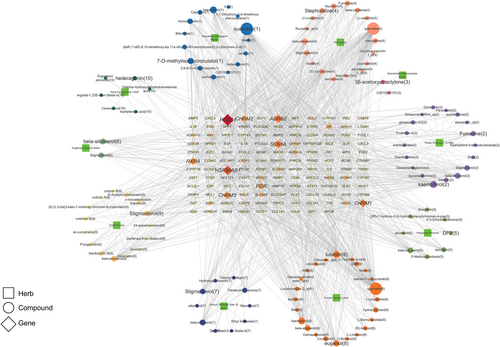
“Drug-active ingredient-core gene” network. Circular nodes, green square nodes, and diamond nodes represent the active ingredients of prescription drugs, components of traditional Chinese medicine, and core gene targets, respectively. The connection line indicates the interaction relationship between the drug, active ingredient, and core gene. The larger the node area, the higher its degree value.
3.2 Protein-Protein Interaction Network Diagram
The PPI visual network diagram was obtained from data processing on the STRING 12.0 platform. After removing discrete nodes, there were 129 nodes and 1769 edges (Figure 2). The core proteins included interleukin-6, activated cysteine proteinase-3 antibody, peroxisome proliferator-activated receptor γ, apoptosis regulator Bcl-2, and transforming growth factor β1 (Figure 3). These targets may play an important role in the treatment of related diseases with Jiuwei Shengmai powder.
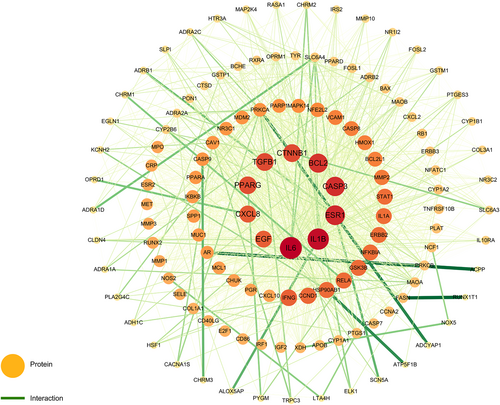
PPIs of the core genes of Jiuwei Shengmai powder. Nodes that have an increasingly larger area and darker color node correspond to higher degree values (the number of edges) and indicate a greater importance. PPI, protein-protein interaction.
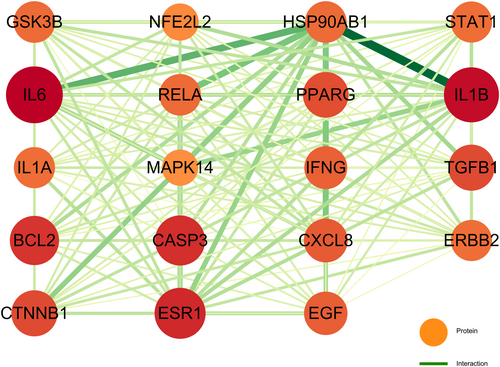
Core PPIs. Nodes that have an increasingly larger area and darker color node correspond to higher degree values (the number of edges) and indicate a greater importance.
3.3 Functional Annotation of Core Genes Using GO
One hundred and twenty-nine core genes were annotated for GO function using the GOPlot package in the R language (Figure 4). The results mainly included reaction to bacteria-derived molecules, lipopolysaccharide, steroid hormone, reactive oxygen species (ROS), and oxygen level reduction, together with gland development, membrane micro-area, outter plasma membrane, DNA binding transcription factor binding, ubiquitin-like protein ligase binding, heme binding, and tetrapyrrole binding. The top 5 most significant GOs in each category were visualized by bubble charts (Figure 5).
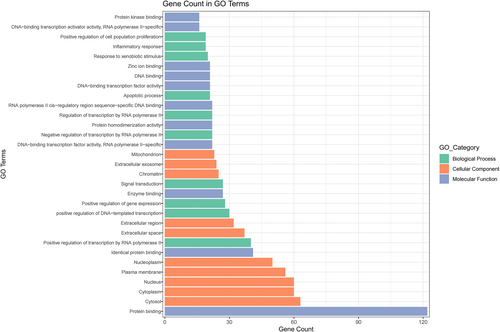
Enrichment of core genes obtained after Venn intersection analysis of the drug-effective active ingredient-core genes.

Top 5 significant GO entries in each category.
3.4 Enrichment of Core Genes by Kyoto Encyclopedia of Genes and Genomes Pathway Analyses
The KEGG pathway of 129 core genes was enriched by org.Hs. for example db packages in R language, and the P and Q values were set to 0.05 in KEGG pathway analyses. The first 20 classes of signaling pathways involving 129 genes are displayed in the bubble diagram (Figure 6). They mainly included the following pathways: lipid and atherosclerosis, PI3K-Akt signaling, mitogen-activated protein kinase (MAPK) signaling, tumor necrosis factor (TNF) signaling, interleukin 17 (IL-17) signaling, apoptosis, and NF-κB signaling. The core genes enriched in each pathway are represented by a Sankey diagram (Figure 7).
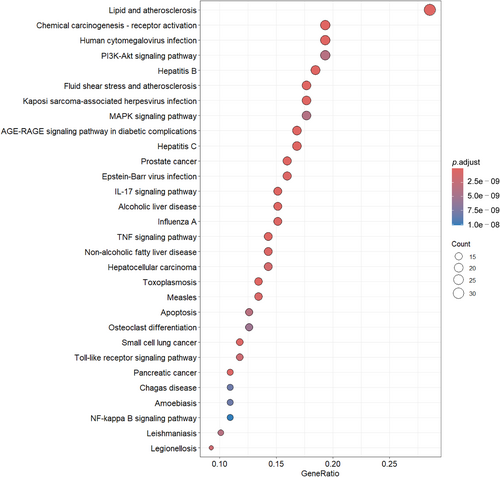
Enrichment of KEGG pathways following Venn intersection analysis of the drug-effective active ingredient-core genes. KEGG, Kyoto Encyclopedia of Genes and Genomes.
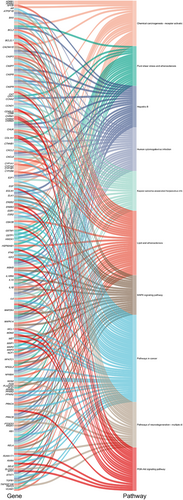
Sankey diagram of core genes. The top 10 KEGG pathways are shown (p < 0.05). KEGG, Kyoto Encyclopedia of Genes and Genomes.
3.5 Molecular Docking
Two core proteins, IL6 and MAPK14, from the PPI network were selected as macromolecular receptors for molecular docking (Supporting Information S1: Table S3 and Figures S3–S9). The docking binding energies between the ligand and protein receptor were all < −5.0 kcal·mol−1 (1 cal = 4.184 J) (Table 1). This implied that the ligands strongly bind to the receptors with lower binding energies corresponding to stronger binding abilities. Figure 8 shows IL6 and quercetin of the molecular docking results.
| rec | lig | Binding energy (kcal·mol−1) | ||
|---|---|---|---|---|
| IL6 (1) | 7NXZ | Quercetin | 1 | −6.25 |
| Kaempferol | 2 | −5.41 | ||
| Naringenin | 3 | −6.35 | ||
| Luteolin | 4 | −6.36 | ||
| MAPK14 (2) | 8VXE | Isorhamnetin | 5 | −8.28 |
| Formononetin | 6 | −8.44 | ||
| Calycosin | 7 | −8.04 | ||
| 3′-Methoxydaidzein | 8 | −8.66 | ||
- Note: The binding energy is less than −5 kcal·mol−1, which indicates that the ligand strongly binds to the receptor. Lower binding energies correlate with stronger binding between the ligand and the receptor. The 7NXZ and 8VXE protein models used for the analysis were retrieved from the PDB database.
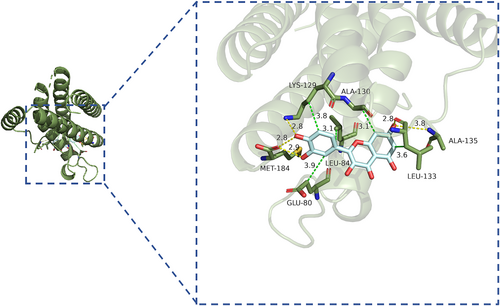
Visualizing the docking between quercetin and IL6 (PDB: 7NXZ) after processing key drug components and core targets. The yellow dotted line and dashed green lines indicate hydrogen bonds and hydrophobicity, respectively.
4 Discussion
It is generally recognized that the main cause of cardiac function injury at high altitude is insufficient myocardial blood supply. As a traditional Chinese medicine, Jiuwei Shengmai powder has great medicinal potential in improving myocardial blood supply. It can enhance the tolerance of the myocardium to hypoxia, make ischemic myocardium lode, and reduce and prolong the survival time of the myocardium [7]. Additionally, quercetin and kaempferol within traditional Chinese medicine have a positive effect on myocardial blood supply by improving myocardial inflammation in clinical practice [8]. Jiuwei Shengmai powder can treat cardiovascular diseases by alleviating myocardial injury, delaying ventricular remodeling and myocardial fibrosis, and improving the left ventricular ejection fraction, and heart rate. It invigorates qi and nourishes yin, with pharmacological research showing that it can enhance myocardial contractility, increase cardiac output and coronary blood flow, reduce vascular resistance, and resist myocardial ischemia to improve cardiac function [6]. These studies show that Jiuwei Shengmai powder has potential therapeutic effects and research value in improving myocardial blood supply. The prevalence and mortality of cardiac insufficiency (also known as heart failure) is high. Heart failure is caused by various heart diseases, including myocardial hypoxia injury [9]. There is a close relationship between heart failure and inflammatory factors. Patients with heart failure are often accompanied by an increase in pro-inflammatory cytokines and modified levels of anti-inflammatory cytokines [10]. An inflammatory reaction after myocardial infarction is necessary for heart repair; however, it is also involved in pathophysiological processes such as heart remodeling and heart failure [11]. The inflammatory pathway plays an important role in enlargement and fiber remodeling of the infarcted heart and the pathological process of heart failure after myocardial infarction [12]. In myocarditis (often caused by viral infections), pathophysiological mechanisms leading to rapid deterioration of the patient's condition include the direct damage of the myocardium by the virus, abnormal activation of the immune system, excessive polarization of macrophages, and indirect damage caused by aggregation in tissues and organs. The autopsy cases selected from the forensic judicial identification center of Guizhou Medical University from January 2017 to December 2019 proved these [13]. Persistent and over-activation of inflammatory reactions may lead to cardiac fibrosis and ventricular dysfunction that can affect the pumping ability of the heart and blood supply of the myocardium [14].
In this study, network pharmacology analysis showed that Jiuwei Shengmai powder and its effective components may affect inflammatory factors through the TNF and IL-17 signaling pathways, reduce the level of pro-inflammatory cytokines, such as TNF-α, interleukin-1β, and interleukin-6, and alleviate inflammatory reactions, resulting in positive effects on myocardial blood supply and cardiac function. Jiuwei Shengmai powder can balance cardiovascular diastolic blood pressure and reduce intramyocardial oxidative stress, inflammation, and myocardial fibrosis by affecting cyclooxygenase 1 (COX-1) activity. TNF-α is produced in two forms: 17 kDa soluble TNF-α (sTNF-α) and 26 kDa membrane-bound TNF-α (tmTNF-α) [15]. Pathophysiological conditions that stimulate TNF-α production include infection and inflammation, burns, trauma, infarction, heart failure, unstable angina pectoris, stroke, brain injury, and asthma [16]. TNF-α plays an important role in inflammation and biological responses, including relaxing blood vessels, causing edema, promoting adhesion between leukocytes and endothelial cells, regulating blood coagulation, and stimulating the production of ROS. TNF-α triggers various intracellular signals by binding TNFR1 or TNFR2, including activation of the MAPK pathway, transcription factors, and caspase in the case of apoptosis [17].
Severe inflammatory reactions following myocardial dysfunction cause chronic excessive increases in ROS and inflammatory cytokines [18]. The design of anti-inflammatory drugs focusing on the treatment of cardiovascular diseases mainly involves inhibiting p38 MAPK-induced inflammation by enhancing cytokines [19]. Inhibiting the p38 MAPK cascade can alleviate the natural progression of pathological left ventricular remodeling and dysfunction [20]. Inhibitors of p38 MAPK can improve the myocardial function of heart failure owing to ischemic injury [21]. Together, this indicates that the p38 MAPK pathway plays an important role in promoting left ventricular remodeling and dysfunction and the progression of heart failure [22].
The IL-17 signaling pathway is mainly activated by serine/threonine kinase initiated by the NF-κB and MAPK pathways, and IL-17 up-regulates the expression of inflammatory genes by inducing or stabilizing target mRNA transcription [23]. IL-17 inhibits the expression of Serca2a and Cav1.2 through the NF-κB pathway, resulting in damage to the functional contraction and structural remodeling of myocardial cells that contributes to the development and occurrence of heart failure. Knockout of IL-17 can improve cardiac function and reduce the hypertrophic growth of the failed heart [24]. Inhibiting activation of the IL-17 signaling pathway may reduce cardiac function damage.
There are three isomers of COX, namely COX-1, COX-2, and COX-3. COX-1 and COX-2 are highly homologous and play an equally important role in cardiovascular health [25]. Under hypertensive conditions, the vasodilator nitric oxide can react with superoxide anion to form a stronger oxidant peroxynitrite that induces the expression of COX-1 and COX-2 as ROS production increases [26]. PhospholipaseA2 converts phospholipid to arachidonic acid, which is catalyzed by COX-1 and COX-2 to Prostaglandin H2. Prostaglandin H2 produces Prostaglandin E2 in response to prostaglandin E synthetase. Prostaglandin E2 is the most abundant prostaglandin in the human body, with four different receptor subtypes (prostaglandin E1 receptor, prostaglandin E2 receptor, prostaglandin E3 receptor and prostaglandin E4 receptor). Prostaglandin E1 receptor promotes the proliferation of cardiomyocytes in vitro [27], which plays a key role in maintaining normal cardiac growth and development, and the absence of prostaglandin E3 receptor can lead to eccentric hypertrophy and fibrosis [28]. Antioxidants or anti-inflammatory agents counteract the negative consequences of COX upregulation during ischemia-reperfusion injury [29].
The results of this study provide a theoretical basis of the active molecules and macromolecules found in Jiuwei Shengmai powder that may improve myocardial hypoxia injury in soldiers at high altitudes. Our follow-up work aims to clinically evaluate the enhanced cardiac function of soldiers at high altitude after ingesting Jiuwei Shengmai powder.
5 Conclusions
Through systematic network pharmacological analysis and molecular docking simulation, this study provides a theoretical basis for the multicomponent interaction between Jiuwei Shengmai Powder and human gene and protein targets. This study provides insights into the mechanism of its cardioprotective properties, which helps to design targeted biochemical studies to clarify the molecular mechanism of reducing myocardial hypoxia injury, with special emphasis on the characteristics of multi-component synergistic effects of traditional Chinese medicine preparations.
Author Contributions
Cong Wu: methodology (equal), visualization (equal), writing – original draft (lead), writing – review and editing (equal). Yanjuan Zhu: validation (equal), visualization (equal). Changpeng Xie: visualization (equal), writing – original draft (equal). Haobo Liu: conceptualization (equal), supervision (equal), writing – review and editing (equal). Yuanming Pan: conceptualization (equal), methodology (equal), visualization (equal), writing – original draft (equal), writing – review and editing (equal). Chang'e Liu: conceptualization (equal), methodology (equal), visualization (equal), writing – original draft (equal), writing – review and editing (equal).
Acknowledgments
We thank our collaborators and advisors for their valuable feedback and support during the preparation of this manuscript.
Ethics Statement
The authors have nothing to report.
Consent
The authors have nothing to report.
Conflicts of Interest
The authors declare no conflicts of interest.
Open Research
Data Availability Statement
The data that supports the findings of this study are available within the article as well as the supplementary materials.



